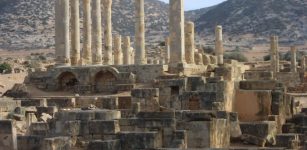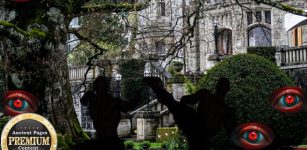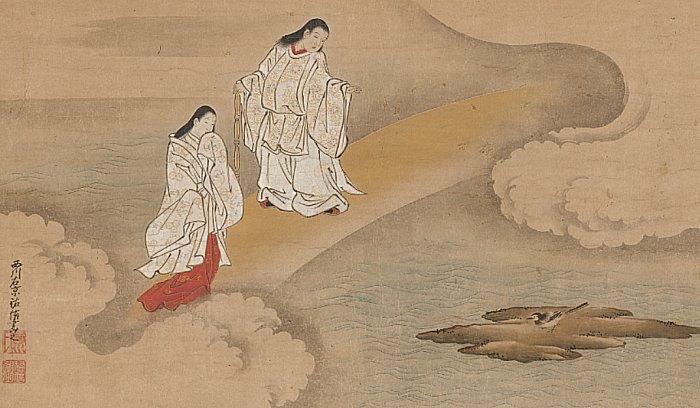Izanagi and Izanami And World Creation In Shinto Cosmology
A. Sutherland - AncientPages.com - Shinto traditions are the cornerstones of Japanese mythology. The origin of the gods and the world dates back to a time before earth and heaven existed.
In Shinto theology, Izanagi and Izanami are considered the progenitors of the world and the Japanese archipelago.
The God Izanagi and Goddess Izanami. Nishikawa Sukenobu Japanese,
At the beginning, there was only a formless mass of swirling gases, of which some slowly began to rise and form the heavens. The denser and darker material sank due to its weight and formed the earth. Then, three divinities created themselves and hid. After them, two other divinities were born, and they, too, hid. It was when the earth—still very young—was moving like a jellyfish.
In this way, seven more gods were born, the last two of which were Izanagi ('Male-who-invites') and Izanami ('Female-who-invites').
This divine pair (brother and sister) are the central deities and creator gods in early Shinto beliefs. They were born after heaven and earth separated out of the endless chaos. The heavenly divinities also commanded them “to complete and solidify the still drifting land."
While standing on the Floating Bridge of Heaven, the siblings looked down into the abyss and wondered if there was anything in the waters of the primeval ocean beneath them. Then, Izanagi plunged his heavenly jeweled spear into the ocean and lifted it. The drop that fell formed the first landmass—an island—Onogoro. The siblings descended on this island and got married there.
Izanagi-jingu Haiden - Shinto shrine located in Awaji, Hyogo Prefecture, Japan. Image credit: ChiefHira - CC BY-SA 3.0
Then, the couple began to procreate the world. First, Izanami released two creations, Hiruko ("floating in mourning") and Ahashima ("the island of foam"). Still, these two did not meet parents' expectations and were rejected for lack of solid consistency.
They learned the art of love-making by watching a pair of wagtails, and these water birds are still associated with the couple. The divine marriage (Izanagi and Izanami) slowly filled the world with mountains, rivers, forests, waterfalls, trees, herbs, and the wind.
Izanami gave birth to new deities successively, but the last one caused the divine pair many troubles. Izanami gave birth to the fire god, became very ill, and soon died.
Izanagi's Descent Into Hell And His Terrible Experience
Izanagi was heartbroken when his wife died and left for Yomi, the Land of Gloom, as the underworld is known in ancient Japanese beliefs.
He followed her to Yomi and met her there. She agreed to return with him to the world of the living on the condition that he would wait for her without entering the Land of the Dead. Izanagi did not keep his promise and followed his lovely wife. He found Izanami's body decomposing and full of worms, watched over by eight gods of thunder. Horrified, Izanagi managed to flee back to the world, but this terrible contact with the world of the dead made him feel very dirty.
He had to undergo ritual purification, and when he washed his left eye, he gave birth to the great goddess Amaterasu, goddess of the Sun. He then washed his right eye and brought into the world the god of the Moon, Tsukiyomi. Then, he washed his nose and gave birth to the god Susanoo, the third of his noble children. (In one version, all three deities were created from Izanagi's eyes.)
Kobayashi Eitaku, Izanagi and Izanami, c. 1885. Upploader: Lamré - Public Domain - source
He appointed Amaterasu, the goddess of the sun and ruler of the High Plain of Heaven. Her brother, Susanoo, became the ocean ruler and god of storms, while her second brother, Tsukuyomi, was appointed the god of the moon.
In this story, through their divine marriage and offspring, Izanagi and Izanami established the nature pattern for all time; however, through their divorce, they created mortal life and death.
The Land of the Living and the Land of the Dead have prohibitions. Izanagi broke some of these prohibitions. In the underworld, Yomi (or the Land of Gloom), there was no prohibition to look at Izanami, and in fact, her husband met her there, but he was not allowed to enter the “Palace” or the “House,” where the process of transition was taking place.
When Izanami was trying to come to life (or rejuvenate) in the “palace,” Izanagi broke the taboo and entered the place; he saw terrible things taking place and her wife’s body decomposing. He broke the laws of the underworld because he interrupted the processes involved in the transition between the worlds of the dead and the living. According to ancient Japanese beliefs, the rejuvenation process should not be disturbed and should be observed by outsiders.
The dead should not be observed during the process of transition.
Written by – A. Sutherland - AncientPages.com Senior Staff Writer
Updated on July 24, 2024
Copyright © AncientPages.com All rights reserved. This material may not be published, broadcast, rewritten or redistributed in whole or part without the express written permission of AncientPages.com
More From Ancient Pages
-
 Stone Age Settlement Discovered Underwater In Finland
Archaeology | Aug 9, 2018
Stone Age Settlement Discovered Underwater In Finland
Archaeology | Aug 9, 2018 -
 Unusual Archaeological Object Reveals Traces Of Prehistoric Settlements Mikołajki
Archaeology | Jun 19, 2023
Unusual Archaeological Object Reveals Traces Of Prehistoric Settlements Mikołajki
Archaeology | Jun 19, 2023 -
 Was The Legendary Tree Of Life Located In The Grove Of Eridu?
Ancient Mysteries | May 19, 2016
Was The Legendary Tree Of Life Located In The Grove Of Eridu?
Ancient Mysteries | May 19, 2016 -
 New Unique Ancient Underwater Finds In The Ports Of Caesarea And Acre
Archaeology | Aug 11, 2021
New Unique Ancient Underwater Finds In The Ports Of Caesarea And Acre
Archaeology | Aug 11, 2021 -
 Identity Of Anti-Christ And Number 666 Revealed By Ancient History Professor
Archaeology | Apr 6, 2019
Identity Of Anti-Christ And Number 666 Revealed By Ancient History Professor
Archaeology | Apr 6, 2019 -
 Mysterious Skull Cult At Göbekli Tepe – Ancestor Worship Or Trophies Of Dead Enemies?
Archaeology | Jul 25, 2017
Mysterious Skull Cult At Göbekli Tepe – Ancestor Worship Or Trophies Of Dead Enemies?
Archaeology | Jul 25, 2017 -
 Pregnant Woman’s Remains With An 8-Month Fetus Unearthed At Ancient Taosibei Cemetery, Shanxi, China
Archaeology | Jun 13, 2022
Pregnant Woman’s Remains With An 8-Month Fetus Unearthed At Ancient Taosibei Cemetery, Shanxi, China
Archaeology | Jun 13, 2022 -
 Discovery Of Camouflaged Ancient Stone Chest In Egyptian Temple May Reveal Hidden Royal Tomb – Who Is Buried Near Hatshepsut’s Temple?
Archaeology | Mar 10, 2020
Discovery Of Camouflaged Ancient Stone Chest In Egyptian Temple May Reveal Hidden Royal Tomb – Who Is Buried Near Hatshepsut’s Temple?
Archaeology | Mar 10, 2020 -
 Underwater Drone Images Reveal Oldest Human-Made Structure In The Baltic Sea
Archaeology | Feb 13, 2024
Underwater Drone Images Reveal Oldest Human-Made Structure In The Baltic Sea
Archaeology | Feb 13, 2024 -
 Aboriginal Legends Tell Millennia-Old Stories Of Events In The Sky
Myths & Legends | Mar 6, 2015
Aboriginal Legends Tell Millennia-Old Stories Of Events In The Sky
Myths & Legends | Mar 6, 2015 -
 University Of Warsaw Archaeologists Return To Study Large Ancient City Of Ptolemais
Archaeology | Sep 8, 2023
University Of Warsaw Archaeologists Return To Study Large Ancient City Of Ptolemais
Archaeology | Sep 8, 2023 -
 Bizarre Towering Pillars Of Externsteine: Myths, Legends And Sacred Rituals From Times Long Gone
Civilizations | Jan 7, 2017
Bizarre Towering Pillars Of Externsteine: Myths, Legends And Sacred Rituals From Times Long Gone
Civilizations | Jan 7, 2017 -
 Zyndram’s Hill: Oldest-Known Stone Wall – A Masterpiece Of Architecture Found In Poland
Civilizations | Sep 15, 2015
Zyndram’s Hill: Oldest-Known Stone Wall – A Masterpiece Of Architecture Found In Poland
Civilizations | Sep 15, 2015 -
 Tusayan Pueblo Ruins And Split Twig Figurines Tell Story Of People Who Once Inhabited The Grand Canyon
Civilizations | Nov 13, 2018
Tusayan Pueblo Ruins And Split Twig Figurines Tell Story Of People Who Once Inhabited The Grand Canyon
Civilizations | Nov 13, 2018 -
 Excavations Begin In Ancient City Of Antiocheia Ad Cragnum, Turkey
Archaeology | Sep 4, 2015
Excavations Begin In Ancient City Of Antiocheia Ad Cragnum, Turkey
Archaeology | Sep 4, 2015 -
 Has a 2,000 Year Old Podium Been Found in the City of David?
Civilizations | Sep 2, 2015
Has a 2,000 Year Old Podium Been Found in the City of David?
Civilizations | Sep 2, 2015 -
 Baffling Unexplained Encounters With Tiny Mysterious Creatures Feeding On Energy
Featured Stories | Feb 20, 2025
Baffling Unexplained Encounters With Tiny Mysterious Creatures Feeding On Energy
Featured Stories | Feb 20, 2025 -
 Traces Of Early Humans Discovered In Southern Iran
Archaeology | Sep 25, 2019
Traces Of Early Humans Discovered In Southern Iran
Archaeology | Sep 25, 2019 -
 On This Day In History: Casanova – Famous Seducer And Adventurer Dies In A Castle In Bohemia – On June 4, 1798
News | Jun 4, 2016
On This Day In History: Casanova – Famous Seducer And Adventurer Dies In A Castle In Bohemia – On June 4, 1798
News | Jun 4, 2016 -
 On This Day In History: Most Notorious Roman Emperor Nero Committed Suicide – On June 9, 68 AD
News | Jun 9, 2016
On This Day In History: Most Notorious Roman Emperor Nero Committed Suicide – On June 9, 68 AD
News | Jun 9, 2016



